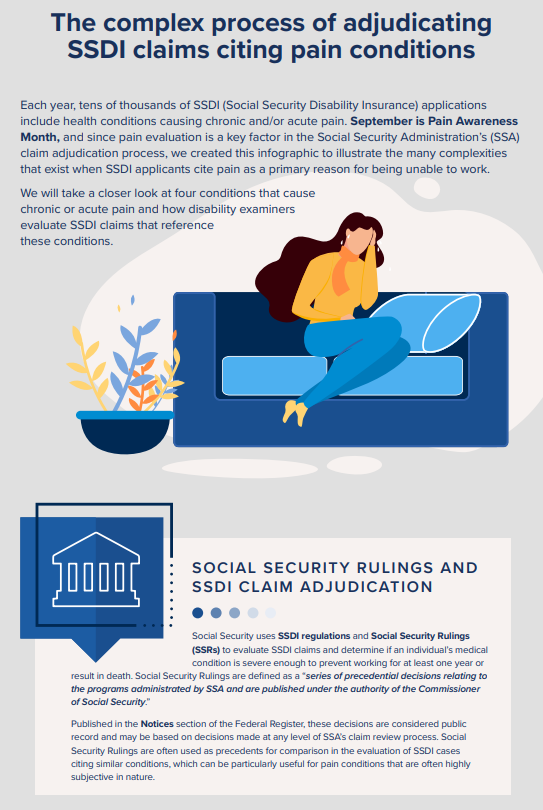The SSDI (Social Security Disability Insurance) claim adjudication process has a reputation for being rigorous, and this is certainly true for many applicants. While some claims are more straightforward, many are complex and require detailed examination to determine if the medical condition(s) listed are severe enough to prevent the applicant from working for at least one year or result in death. This can be particularly difficult for pain-related conditions, as pain is difficult to prove with objective evidence outside personal testimony. Additionally, pain is a symptom of many health conditions, and Social Security cannot approve a claim for SSDI benefits without pinpointing a direct cause. This can leave claimants living with severe pain feeling frustrated when their SSDI application is denied or when there is not enough evidence on file to support their claim.
September is Pain Awareness Month, and we created this infographic to dive deeper into the conversation about pain by exploring how SSDI claims citing pain may face additional obstacles when seeking an approval.
When an SSDI application is filed, the Social Security Administration (SSA) uses SSDI regulations and Social Security Rulings (SSRs) to evaluate the claim and determine if it meets the criteria for an SSDI award. Social Security Rulings are defined as a “series of precedential decisions relating to the programs administrated by SSA and are published under the authority of the Commissioner of Social Security.” These rulings, which are updated regularly and publicly available, are particularly useful when evaluating pain-related conditions that are often highly subjective in nature.
Unfortunately, SSRs do not exist for all disabling conditions, which highlights the importance of thorough, consistent medical records, including evidence of testing, treatment, and symptoms over an extended period of time. The importance of objective medical evidence cannot be overstated. In fact, according to SSA’s code of regulations, “[i]n determining whether you are disabled, we consider all your symptoms, including pain, and the extent to which your symptoms can be reasonably accepted as consistent with the objective medical evidence and other evidence…There must be objective medical evidence from an acceptable medical source that shows you have a medical impairment which could reasonably be expected to produce the pain or other symptoms alleged and that, when considered with all of the other evidence (including statements about the intensity and persistence of your pain or other symptoms which may reasonably be accepted as consistent with the medical signs and laboratory findings), would lead to a conclusion that you are disabled.”
We created this infographic about the complex process of adjudicating SSDI claims citing pain-related conditions to help claimants better understand how they can improve their likelihood of receiving an SSDI award for a condition that causes pain. It takes a closer look at four conditions that cause chronic or acute pain, how disability examiners evaluate SSDI claims citing these conditions, and what evidence may be most beneficial to have in a claimant’s file.





